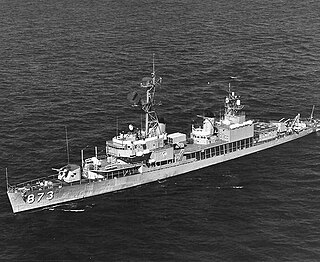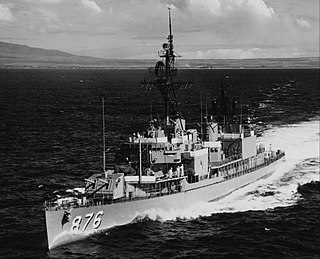
USS Lawrence (DD-954/DDG-4) was a Charles F. Adams class guided-missile destroyer in the United States Navy. It was the fifth ship named after Captain James Lawrence USN (1781–1813). The USS Lawrence served on blockade duty during the Cuban Missile Crisis in October 1962 and, in 1972, was part of Operation Linebacker in the west Pacific.

USS Dyess (DD/DDR-880), a Gearing-class destroyer, was a ship of the United States Navy named for Aquilla James Dyess (1909–1944). Dyess was awarded the Medal of Honor posthumously for his leadership of his battalion of Marines in the Battle of Kwajalein. The ship was laid down by Consolidated Steel Corporation at Orange, Texas on 17 August 1944, launched on 26 January 1945 and commissioned on 21 May 1945. The vessel spent the majority of her career patrolling the Mediterranean Sea with NATO forces. The ship was decommissioned on 27 January 1981 and sold to Greece the same year for spare parts.

USS Furse (DD-882/DDR-882) was a Gearing-class destroyer of the United States Navy.

USS Stickell (DD-888) was a Gearing-class destroyer of the United States Navy in service from 1945 to 1972. She was renamed HS Kanaris (D212) in 1972 on transfer to the Hellenic Navy.

USS Hawkins (DD-873) was a Gearing-class destroyer in the United States Navy during World War II. Following the war, the ship saw service in the Korean War and in the 1970s, was transferred to the Republic of China Navy as Tze Yang. She remained in service until the 1990s. The ship was then scrapped with the exception of her superstructure, which became part of a display and training ground at the Zuoying Naval Academy.

USS Rogers (DD-876) was a Gearing-class destroyer of the United States Navy. She was named for three brothers — Jack Ellis Rogers Jr., Charles Ethbert Rogers, and Edward Keith Rogers — killed in action aboard USS New Orleans during the Battle of Tassafaronga in the Solomon Islands on 30 November 1942.

USS Leary (DD/DDR-879), one of the longest-lasting Gearing-class destroyers, was the second ship of the United States Navy to be named for Lieutenant Clarence F. Leary USNRF (1894–1918), who lost his life in the line of duty. He was posthumously awarded the Navy Cross.

USS Vogelgesang (DD-862) was a Gearing-class destroyer in the United States Navy. She was named for Rear Admiral Carl Theodore Vogelgesang USN (1869–1927).

The second USS Steinaker (DD-863/DDR-863/DD-863) was a Gearing-class destroyer of the United States Navy.

USS Harold J. Ellison (DD-864) was a Gearing-class destroyer in service with the United States Navy from 1945 to 1983. She was then transferred to Pakistan and renamed Shah Jahan (D-164). The ship was finally sunk as a target in 1994.

USS Stribling was a Gearing-class destroyer in the United States Navy. She was the second US Navy ship named for Admiral Cornelius Kincheloe Stribling.

USS Warrington (DD-843) was a Gearing-class destroyer that served the U.S. Navy from the end of World War II to the Vietnam War, when she was damaged by two underwater explosions, causing her to be listed as "beyond repair" and excessed to the Navy of the Republic of China.

USS Myles C. Fox (DD/DDR-829) was a Gearing-class destroyer in the United States Navy during World War II and the years following. She was named for Myles C. Fox, a USMC lieutenant who was posthumously awarded the Navy Cross for actions during World War II.

USS William R. Rush (DD/DDR-714) was a Gearing-class destroyer in the United States Navy. She was named for William R. Rush.

USS Eugene A. Greene (DD/DDR-711) was a Gearing-class destroyer of the United States Navy, named for Ensign Eugene A. Greene (1921–1942), who was posthumously awarded the Navy Cross for his heroism in the Battle of Midway.

USS Kenneth D. Bailey (DD-713/DDR-713) was a Gearing-class destroyer in the United States Navy during World War II. She was named for Kenneth D. Bailey. The name Kenneth D. Bailey was originally assigned to the destroyer escort USS Kenneth D. Bailey (DE-552) on 30 November 1943; DE-552 was cancelled on 10 June 1944, and the name was reassigned to DD-713 on 8 July 1944.

USS William M. Wood (DD/DDR-715) was a Gearing-class destroyer in the United States Navy during the final year of World War II. She was in commission for 31 years, from 1945 through 1976, serving in both the Pacific and Atlantic Fleets. She was the second Navy ship named for Navy Surgeon-General William M. Wood (1809–1880).

USS Corry (DD/DDR-817) was a Gearing-class destroyer of the United States Navy, the third Navy ship named for Lieutenant Commander William M. Corry, Jr. (1889–1920), a naval aviator who was posthumously awarded the Medal of Honor.

USS Fiske (DD/DDR-842) was a Gearing-class destroyer of the United States Navy, the second Navy ship named for Rear Admiral Bradley A. Fiske (1854–1942), inventor of the Stadimeter and the aerial torpedo.

Destroyer Squadron 26 (DESRON-26) is a destroyer squadron of the United States Navy. It was first created in 1950. It has seen action in the Korean War, service in the Atlantic, in the Vietnam War. From 1974 for a period it became the 'Mod Squad', trialling ships commanded by officers one rank junior to the usual appointment rank.






















